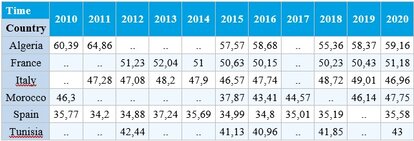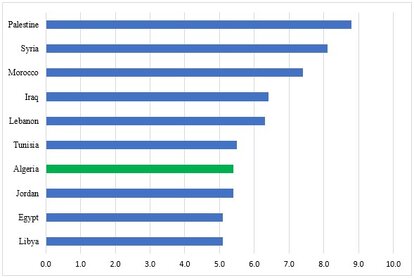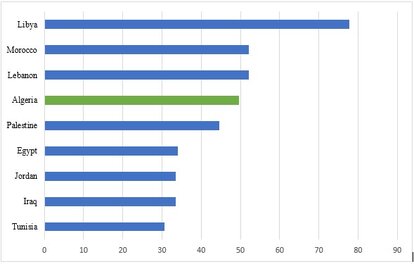YOUTH
The migration of young Mediterranean talent and the challenge of employability

Brain drain: blessing or curse?
It is sometimes considered in terms of inequalities between countries, with controversial results for developing countries (Frédéri, 2007). Some of the literature from the 1960s onwards was pessimistic, focusing on the loss of human capital in countries of origin (Bhagwati & Hamada, 1974) and (Portes, 1976). By the mid-1990s, the view was more optimistic, emphasising the long-term positive effects of a "brain gain" in countries of origin (Stark, 1989), a thesis shared by others (Vidal, 1998) and (Beine & all, 2006) and defended to this day (World Bank, 2023).
The "brain drain" is intimately linked to economic prospects, and both shores of the Mediterranean are confronted with it. The migration phenomenon has evolved over time, especially in the South, from labour migration to skills migration (Hadibi, 2019), with important implications for the Northern shore. It fills the gap in the North and reduces labour market stress in the South (Musette, 2022).
Massification of higher education and employability
Countries on both shores of the Western Mediterranean have the highest levels of gross university enrolment. The Organisation for Economic Cooperation and Development (OECD) definition includes the university student segment in its definition of talent. With the exception of Tunisia, all countries show an upward trend in terms of university enrolment.

Table 01: Enrolment in tertiary education, all programmes, both sexes (number)
© Source: United Nations Educational, Scientific and Cultural Organization-UNESCO Institute for Statistics (2023)."Unemployed graduates" is a recurrent expression. The countries on the southern shores of the Mediterranean have a high rate of unemployment among university graduates. There is a consensus on the mismatch between training and the productive sector, especially among graduates in the broad field of Humanities and Social Sciences.

Table 02: Percentage of students enrolled in Humanities, Social Sciences, Commerce, Law and Administration degrees
© Source: UNESCO Institute for Statistics (2023)The employability of graduates in SHS, a very popular discipline, is problematic. The public sector can no longer absorb as many graduates, and STEM graduates tend to have easier access to the labour market (ICMPD, 2021). The unemployment rate among tertiary graduates is 18.5% in Algeria (ONS, 2018), 26.4% in Morocco (HCP, 2016) and 28.6% in Tunisia (INS, 2015). It is lower in France, estimated at 8.1 % (INSEE, 2022), and 8 % in Spain, including 13.4 % for Arts and Humanities graduates (INE, 2019). The private sector and changes in the labour market in the light of the technological and digital revolutions favour technical skills.
Migration of young Mediterranean talent
Reading the data in Figure 1 illustrates the ranking by score of brain drain in MENA countries; all countries, with some differences, are affected. Figure 2 provides information on the significant out-migration intention of tertiary graduates.

Figure 1: Brain drain in MENA - Middle East and North Africa
© Source: Data extracted from the Fragile States Global Report (2022) and ABV data (2023).
Figure 2: Intention by education level (%)
© Source: Data extracted from the Fragile States Global Report (2022) and ABV data (2023).Destination countries are mainly OECD countries, North America and some Middle Eastern countries (Qatar and the United Arab Emirates). It is true that Europe is experiencing a decline (European, 2023) in its working age population (3.5M between 2015 and 2020 and 35M in 2050). To a lesser extent, European countries are also seeing their talents leaving for various reasons; especially economic, in the case of Spain after the 2008 crisis (Romero-Valiente), with higher migration of graduates in Social Sciences and Humanities (36%), Law and Economics (23.5%), Mathematics and Natural Sciences (11.5%) and Computer Science (7%). This skilled migration is a consequence of the economic crisis and has affected Spain, but also Italy, Portugal and Greece (González-Enríquez, 2017). Unemployment among young graduates is a challenge shared by young people on both sides of the Atlantic, along with retraining and the mismatch between training and employment, with the exception of STEM fields. Yet in many respects there are more social trade-offs in the North than in the South.
Qualified young people in the Mediterranean suffer from a lack of career prospects, and emigration is now emerging as an alternative. It is true that more and more are leaving the South, but the race for global talent is tough, and Europe admits that it is currently losing out: 'The EU is losing the global race for talent' (European Commission, 2020). Investing in human capital is the goal of the Global Compact for Safe, Orderly and Regular Migration to "reduce youth unemployment, prevent brain drain and optimise brain gain in countries of origin and capitalise on the demographic dividend" (United Nations, 2018).
BIBLIOGRAPHY
Beine & all. (2006). Skilled migration, human capital inequality and convergence. manuscript, Université Catholique de Louvain-La-Neuve.
Bhagwati & Hamada. (1974). The brain drain, international integration of markets for professionals and unemployment: a theoretical analysis. Journal of Development Economics, pp. 1(1), 19-42.
Commission européenne. (2020). COMMUNICATION DE LA COMMISSION AU PARLEMENT EUROPÉEN, AU CONSEIL, AU COMITÉ ÉCONOMIQUE ET SOCIAL EUROPÉEN ET AU COMITÉ DES RÉGIONS sur un nouveau pacte sur la migration et l'asile. Bruxelles.
europea, C. (2023 , enero 17). Aprovechar el talento en Europa: un nuevo impulso para las regiones de la UE. Bruselas.
Frédéri, D. (2007). Fuite des cerveaux et inégalités entre pays. Revue d'économie du développement, (2), 049-088, pp. p. 49-88.
González-Enríquez, C. &. (2017). La emigración española cualificada tras la crisis. Una comparación con la migración desde el Sur de Europa e Irlanda. Migraciones. Publicación Del Instituto Universitario De Estudios Sobre Migraciones, (43), 117–145.
Hadibi, Z. (2019). L’Algérie, de l’émigration ouvrière a la mobilité des compétences a la lumière de la globalisation? Logiques et déterminants de mobilités transnationales. Áreas. Revista Internacional de Ciencias Sociales, (38), 61-72.
ICMPD. (2021). Jeunesse et Mobilité au Maghreb: Une Evaluation des Aspirations de la Jeunesse en Algérie, Libye, Maroc et Tunisie. Malta: Regional Office for the Mediterranean.
Mountford, A. (1997). Can a brain drain be good for growth in the source economy? Journal of development economics, pp. 53(2), 287-303.
Musette, S. M. (2022). Fuite des cerveaux dans les pays du sud de la Méditerranée. IEMed Annuaire Méditerranéen.
Nations Unies. (2018). Pacte mondial pour des migrations sûres, ordonnées et régulières. A/RES/73/195.
Portes, A. (1976). Determinants of the brain drain. International Migration Review, pp. 10(4), 489-508.
Romero-Valiente, J. M. (n.d.). Causas de la emigración española actual: la “movilidad exterior” y la incidencia de la crisis económica. Boletín de la Asociación de Geógrafos Españoles, 76, 303-328.
Stark, O. H. (1989). Human capital depletion, human capital formation, and migration: a blessing or a “curse”? Economics Letters, pp. 60(3), 363-367.
Vidal, J. P. (1998). The effect of emigration on human capital formation. Journal of population economics, pp. 11(4), 589-600.
World Bank. (2023). World Development Report- Migrations, Refugees and Society. GWB. Retrieved from https://www.worldbank.org/en/publication/wdr2023
